Pickleball is a sport played with paddles that combines tennis, badminton, and ping pong. It involves playing on a court that is smaller than for tennis, along with a low net, but with a paddle and perforated plastic ball. Players can play doubles or singles, and the game is famous for being simple to learn but difficult to master in competitive play. Originally developed in 1965, it has gained popularity among players of every age. The game is very accessible, taking little equipment and space, thus leading to its fast growth across the United States and worldwide.
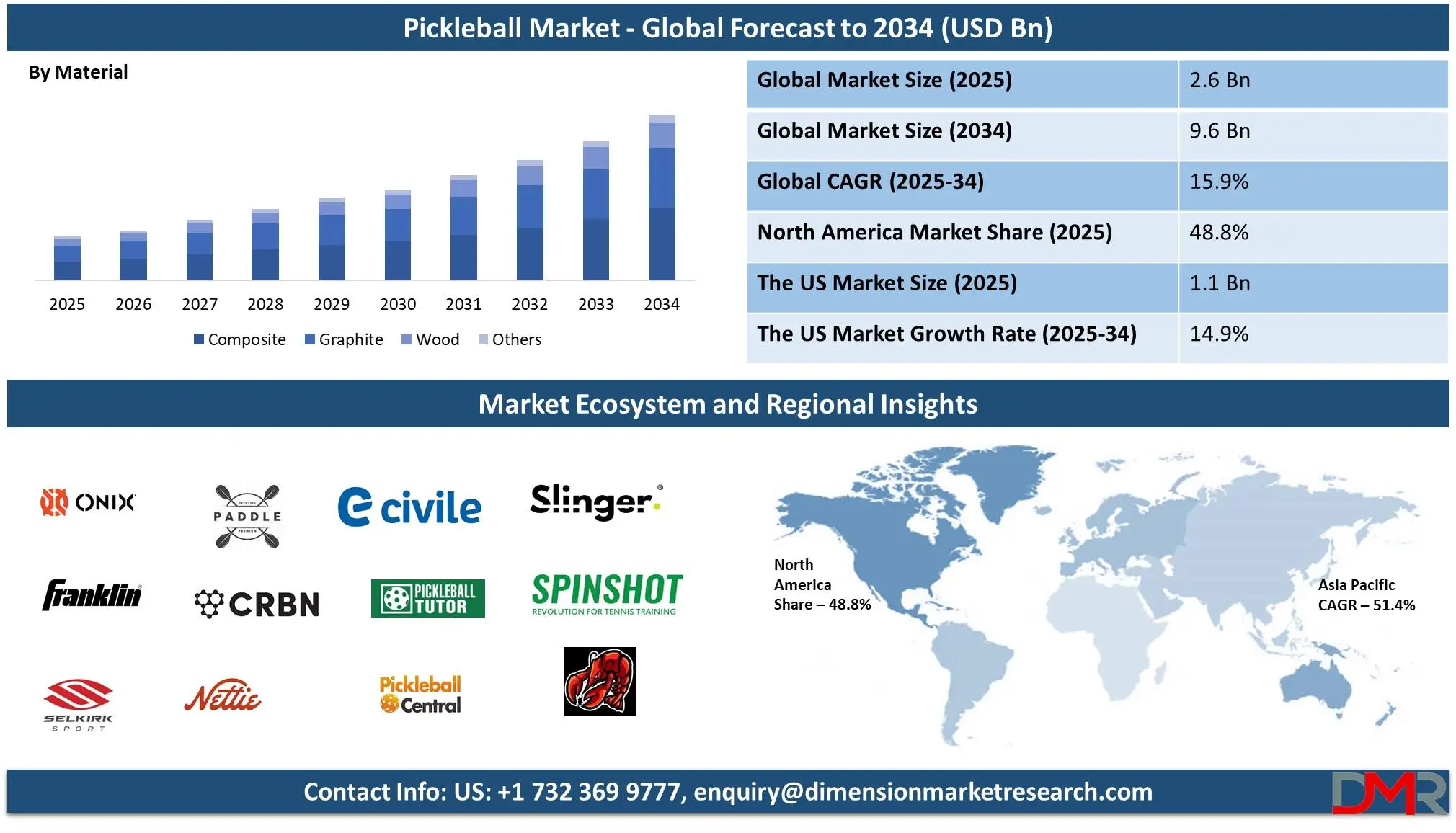
Over the past few years, the need for pickleball facilities and courts has increased as the sport has gained more followers. Additional cities and communities are putting funds into new courts, with sole-purpose pickleball facilities under construction to accommodate the popularity of the sport. Although repurposed tennis courts are used by players, the popularity of the game has created the need for stand-alone pickleball courts. As the sport continues to grow, so do formal tournaments, coaching programs, and professional leagues, making pickleball a competitive and organized sport on various levels.
Pickleball, once a niche sport, has quickly become one of the fastest-growing activities in the U.S. and around the world. But its importance goes far beyond just being another game Pickleball plays a crucial role in promoting
health and wellness, building community, and even driving growth in the
sports equipment industry.
Pickleball has seen a consistent increase in players, with millions of new participants entering the sport annually. The sport is attractive to a diverse group of individuals, from older adults looking for a low-impact sport to younger players who want a quick-paced game. Endorsements from athletes and celebrities, as well as media coverage, have helped raise awareness. Schools, gyms, and recreation centers are increasingly adding pickleball programs, so its presence continues to grow.
Event-wise, pickleball currently hosts prominent national and international tournaments. Among the sport's elite events is the USA Pickleball National Championships, which brings the world's best players to its site. The U.S. Open Pickleball Championships and the various regional and professional circuit tournaments are other key events. The events provide a competitive forum for players across levels and help to promote the growth of the sport.
As pickleball expands, safety and equipment development have become necessary. Increasingly, injury prevention is being researched, as sudden movements and falls can result in sprains and fractures, particularly among senior players. Improved paddle technology and playing surfaces are improving performance while decreasing player stress. Referee education and rule revisions guarantee fair and structured play as the sport evolves.
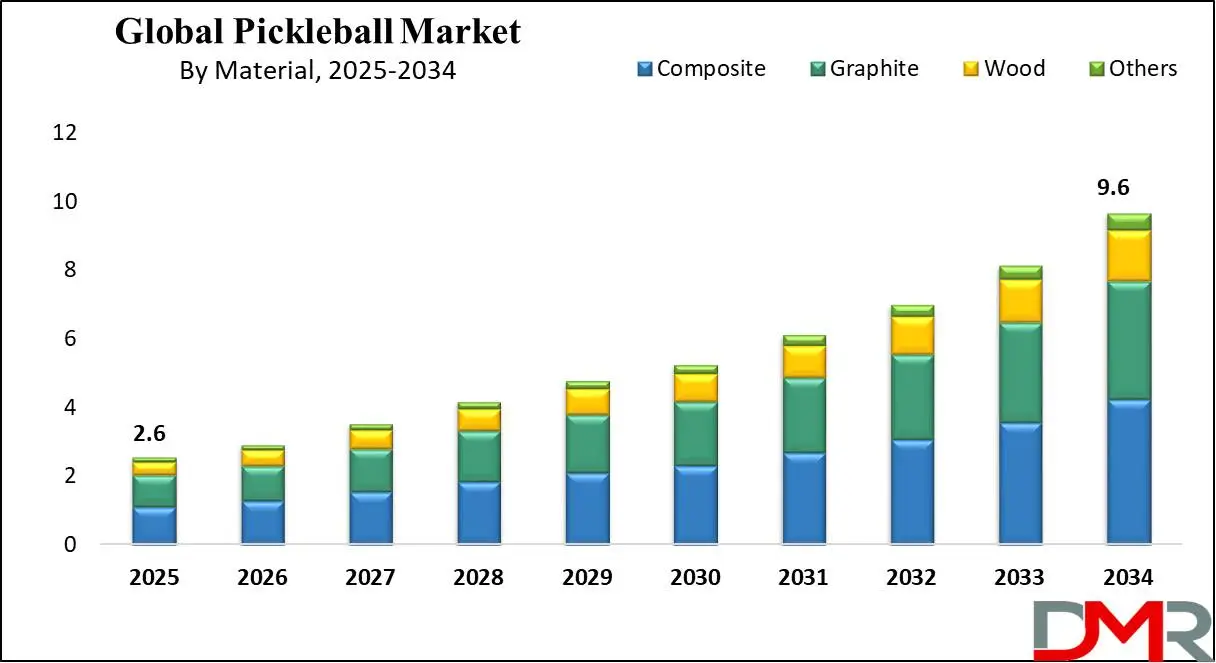
The future of pickleball is bright as it continues to see rising participation. Plans to construct additional courts, enhance training initiatives, and promote the sport among younger generations will ensure its growth. As the sport receives increased professional attention and international exposure, it will only become a larger part of the recreational and competitive sports landscape around the globe.
The US Pickleball Market
The US Pickleball Market is projected to reach USD 1.1 billion in 2025 at a compound annual growth rate of 14.9% over its forecast period.
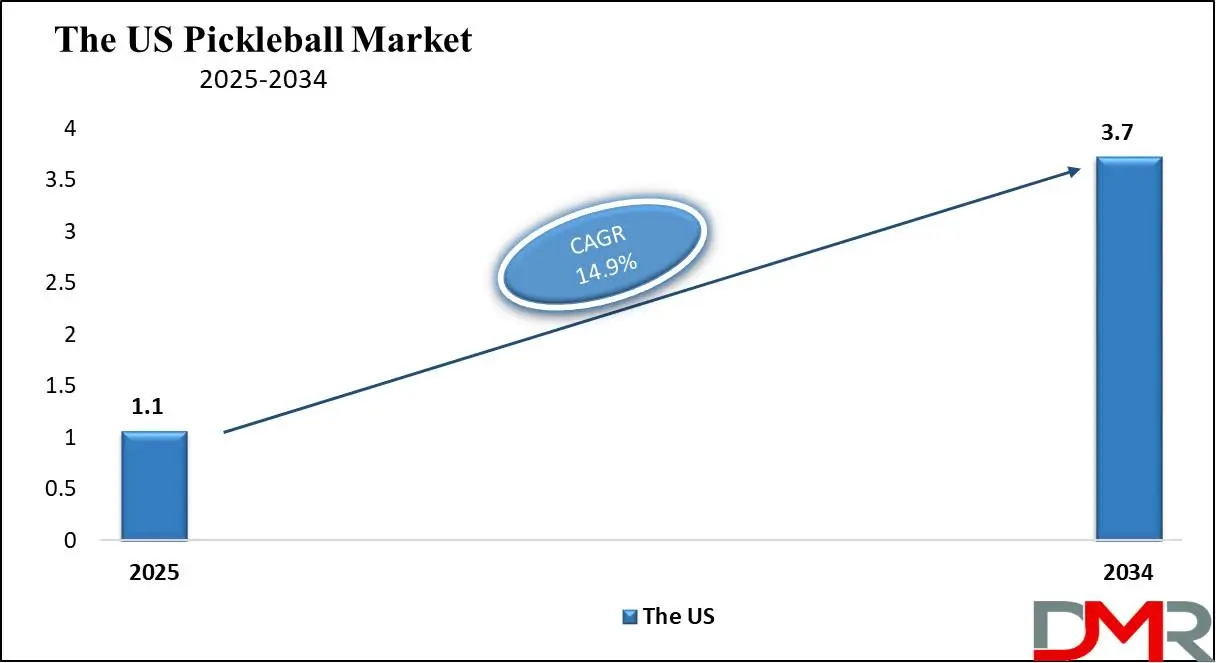
US growth opportunities in the pickleball market are abundant due to increasing participation, expanding facilities, and rising consumer interest. The sport appeals to diverse age groups, leading to higher demand for quality equipment, coaching, and tournaments. Retail and e-commerce channels are capitalizing on this trend, while community programs and corporate partnerships further drive market expansion and innovation in the US.
In the US, strong consumer interest and increased participation drive pickleball market growth, driven by growing recreational facilities, community programs, and rising health awareness. However, limited infrastructure in urban areas and occasional regulatory challenges act as restraints. While the sport benefits from a rise in fan base of players and corporate sponsorships, addressing space constraints and zoning issues remains critical to ensure sustainable expansion of pickleball across the country, unlocking market potential.
Pickleball Market: Key Takeaways
- Market Growth: The Pickleball Market size is expected to grow by 6.7 billion, at a CAGR of 15.9%, during the forecasted period of 2026 to 2034.
- By Court Type: The Outdoor segment is anticipated to get the majority share of the Pickleball Market in 2025.
- By Material: The composite segment is expected to get the largest revenue share in 2025 in the Pickleball Market.
- Regional Insight: North America is expected to hold a 48.8% share of revenue in the Global Pickleball Market in 2025.
- Use Cases: Some of the use cases of Pickleball include fitness & wellness, competitive play, and more.
Pickleball Market: Use Cases
- Community Engagement: Pickleball brings people together, promoting social interaction and active lifestyles in neighborhoods, senior centers, and recreational clubs.
- Fitness & Wellness: A low-impact sport suitable for all ages, providing cardiovascular benefits, enhancing agility, and promoting overall physical well-being.
- Competitive Play: Provides structured tournaments at local, national, and international levels, catering to amateur and professional players alike.
- Facility Development: Growing demand has led to new dedicated courts, multi-sport complexes, and investments in infrastructure to support the sport’s expansion.
Stats & Facts
- Pickleball’s infrastructure is expanding at an unprecedented pace, with Pickleheads reporting a total of 68,458 courts nationwide after adding 18,455 new locations in 2024 alone.
- The sport continues to dominate as America’s fastest-growing activity, as SFIA highlights, with participation skyrocketing by 223.5% over the last three years.
- Competitive play is at an all-time high, with USA Pickleball sanctioning 142 tournaments in 2024, including the prestigious Biofreeze USA Pickleball National Championships and 13 Golden Ticket events.
- While the game is thrilling, injuries are a growing concern. Piasta Walker’s study reveals that 90% of pickleball-related ER visits involve players over 50, with sprains and fractures being the most common.
- The rapid rise in participation has also led to a 200% spike in bone fractures over the last 20 years, according to the American Academy of Orthopaedic Surgeons, with 92% of injuries caused by falls.
- Younger players are embracing pickleball like never before. SFIA reports that the 25–34 age group now leads participation with 2.3 million players, and over 1 million children under 18 have taken up the sport since 2022.
- Refereeing standards are improving, as USA Pickleball confirms, with over 1,100 members in its officiating program, a 9% rise in Certified Referees, and a 7% increase in Level 1 and Level 2 referees.
- Despite a 55% growth in dedicated courts, demand continues to outpace supply. Pickleheads estimates that $855 million is still needed to develop enough facilities in the next 5–7 years.
- Equipment innovation is thriving, with USA Pickleball approving 1,225 paddles and 81 balls in 2024 after testing 1,713 new paddle and ball submissions.
- Major U.S. cities are finally catching up in infrastructure, as SFIA & Pickleheads report, with New York, Los Angeles, and Chicago doubling their dedicated courts per 10,000 people—though they still lag 92% behind the national average.
- Passionate ambassadors are helping the sport flourish, with USA Pickleball recognizing 2,051 dedicated representatives promoting pickleball across the country.
- Coaching is evolving rapidly, as Pickleball Coaching International (PCI) reveals, with 1,037 U.S. members, 1,422 global members, and 895 new signups for its latest Level 1 coaching course.
- The 2024 Biofreeze USA Pickleball National Championships was a massive success, according to USA Pickleball, attracting 2,600 players from 47 states and 13 countries, 10,000 spectators, and generating $3.6 million in economic impact.
- Some regions are experiencing explosive participation rates, with SFIA highlighting the South Atlantic as the fastest-growing, seeing a 50% rise in players in 2023, totaling 2.8 million.
- Inclusivity in the sport reached a major milestone, as USA Pickleball proudly introduced wheelchair pickleball at the 2024 Biofreeze USA Pickleball National Championships, giving adaptive players a chance to compete at the highest level.
Market Dynamic
Driving Factors in the Pickleball Market
Expansion of Facilities and InfrastructureThe fast growth of pickleball has led to a growth in demand for dedicated courts and playing spaces. Cities, private clubs, and sports organizations are highly investing in building specialized pickleball facilities to accommodate the growth in the number of players. While many games still take place on converted tennis or basketball courts, purpose-built venues are becoming more common, providing better playing conditions and amenities. Residential communities, resorts, and retirement villages are integrating pickleball courts to attract residents and guests.
In addition, the development of construction materials and noise-reducing technologies are helping make pickleball courts more accessible in urban and suburban areas. With feasibility studies and AI-powered assessments supporting new facility development, the sport's infrastructure is expanding at a fast pace. This investment ensures long-term sustainability and accessibility, making it easier for players to engage in the sport at all levels.
Commercialization and Professionalization
The rising commercialization of pickleball is another key driver of its market growth, with major brands, sponsors, and media platforms recognizing its potential. Equipment manufacturers are continuously innovating, launching high-quality paddles, balls, and apparel to cater to both amateur and professional players. Televised and live-streamed pickleball tournaments have gained traction, attracting new audiences and advertising revenue.
The formation of professional leagues has provided career opportunities for elite athletes, further elevating the sport’s status. Structured coaching programs, certification courses, and collegiate-level pickleball teams are expanding, strengthening the player pipeline. Additionally, endorsements from celebrities and influencers have significantly boosted pickleball’s visibility, making it more mainstream. With sponsorship deals, event partnerships, and media coverage increasing each year, the professionalization of pickleball is fueling its rapid market expansion.
Restraints in the Pickleball Market
Limited Infrastructure and Court Availability
Despite its rapid growth, the pickleball market experiences challenges due to a shortage of dedicated courts and playing facilities. Many players still depend on shared or repurposed tennis and basketball courts, leading to overcrowding and scheduling conflicts. Urban areas, in particular, struggle to keep up with demand due to space constraints and zoning restrictions. Noise complaints from nearby residents have also created barriers to court development, with some communities imposing restrictions or opposing new pickleball facilities.
In addition, funding for public pickleball infrastructure remains limited, making it difficult for cities and recreation centers to build new courts. While private investments are growing, accessibility can be an issue as many premium courts require membership fees or paid reservations. Without adequate infrastructure expansion, the sport’s growth could slow, limiting participation opportunities.
Injury Risks and Player Safety Concerns
As participation in pickleball continues to rise, so do concerns about player injuries, particularly among older adults, who make up a significant portion of the player base. Quick lateral movements, sudden stops, and frequent direction changes increase the risk of ankle sprains, muscle strains, and falls. Studies have shown that fractures, particularly in the wrist and forearm, are common due to falls during play.
The growth in the number of injuries has also led to increased healthcare costs and concerns about long-term player safety. While proper warm-ups, training, and court surfaces can help reduce injury risks, many casual players may not follow these best practices. In addition, as the sport gains popularity among younger athletes, overuse injuries and competitive play-related strains are becoming more prevalent. Addressing these safety challenges will be crucial in ensuring that the sport remains accessible and sustainable for all age groups.
Opportunities in the Pickleball Market
Expansion into International Markets
While pickleball has seen explosive growth in the U.S., there is a vast opportunity to expand the sport globally. Countries in Europe, Asia, and South America are beginning to embrace pickleball, but infrastructure and awareness remain limited. Establishing international leagues, hosting global tournaments, and forming partnerships with sports organizations can accelerate worldwide adoption. The Olympics and other international sporting bodies are also showing interest, which could further drive global participation.
Additionally, manufacturers and brands have a chance to introduce pickleball equipment and training programs to new markets, catering to different playing styles and regional preferences. By developing localized marketing strategies and collaborating with international sports federations, pickleball can position itself as a truly global sport. This international expansion will not only increase the player base but also create new revenue streams for equipment sales, sponsorships, and events.
Integration with Schools and Fitness Programs
Pickleball’s accessibility and health benefits make it an ideal sport for integration into schools, colleges, and fitness centers. Schools can introduce pickleball as part of their physical education curriculum, helping younger generations develop skills and long-term interest in the sport. Universities and colleges are also starting to adopt pickleball as a competitive sport, which could lead to the formation of intercollegiate leagues and scholarships.
Beyond education, fitness centers and wellness programs can incorporate pickleball as a low-impact workout option for people of all ages. Corporate wellness initiatives can also use pickleball to promote teamwork, stress relief, and physical activity among employees. By tapping into these institutions, pickleball can expand its reach beyond recreational and professional players, ensuring sustained market growth while fostering a healthier and more active community.
Trends in the Pickleball Market
Rise of Professional Leagues and Media Coverage
The higher professionalization of pickleball is a major trend shaping the market, with new leagues, high-stakes tournaments, and media partnerships bringing the sport into the mainstream. Major organizations like the Professional Pickleball Association (PPA) and Major League Pickleball (MLP) are hosting high-profile events that attract top athletes, sponsors, and television deals. Live broadcasts and streaming platforms have expanded pickleball’s reach, making it more accessible to global audiences.
The involvement of celebrity investors, including athletes and entertainers, has further boosted the sport’s credibility and visibility. With prize money increasing and dedicated pickleball venues being built for professional play, more athletes are transitioning from recreational to competitive levels. As sponsorships and endorsements grow, pickleball’s presence in mainstream sports media constantly strengthens, which is fueling greater participation and turning pickleball into a commercially viable professional sport.
Technological Innovations in Equipment and Training
Developments in technology are transforming pickleball equipment and training, enhancing both performance and accessibility. Paddle manufacturers are using advanced materials like carbon fiber and polymer cores to create lightweight, durable, and high-performance paddles. Smart paddles with built-in sensors are emerging, providing real-time analytics on shot accuracy, speed, and spin to help players improve their game. Wearable fitness trackers and AI-powered coaching apps are also being integrated into pickleball training, offering personalized feedback and performance tracking.
Additionally, online coaching platforms and virtual training sessions are making professional instruction more accessible to players of all levels. Noise-reducing court surfaces and advanced ball designs are addressing community concerns about sound levels, making the sport more neighborhood-friendly. These technological innovations are not only improving the player experience but also driving demand for premium pickleball products and services.
Research Scope and Analysis
By Product Type Analysis
The paddles segment is set to be leading in 2025 with a 39.3% market share, playing a key role in the growth of the pickleball market. As players look for better performance, lightweight and durable paddles made from carbon fiber and polymer cores are becoming more popular. Innovation in paddle design, like better grip technology and vibration dampening, is enhancing player comfort and control. With professional leagues expanding and more people joining the sport, demand for high-quality paddles is rising. Manufacturers are also introducing smart paddles with built-in sensors for tracking performance. As more beginners and competitive players enter the sport, the paddle market continues to drive overall industry growth.
Further, the accessories segment is having significant growth over the forecast period due to the increasing popularity of pickleball among casual and competitive players. Items like specialized bags, grips, protective gear, and training aids are in high demand as players look for convenience and enhanced gameplay. Wristbands, apparel, and hydration accessories are also growing in popularity, reflecting the sport’s active and social culture. As pickleball expands into schools, clubs, and professional leagues, the need for accessories continues to rise. Retailers and online stores are experiencing increased sales, making accessories a key contributor to market expansion and providing additional revenue streams for manufacturers.
By Material Analysis
In terms of material, the composite segment will be leading in 2025 with a 43.8% market share of the pickleball market with its advanced material technology. Composite paddles, made from fiberglass, carbon fiber, and polymer cores, provide a perfect balance of power, control, and durability, making them the preferred choice for both amateur and professional players. Their lightweight structure reduces strain on the wrist, allowing for longer play sessions without fatigue.
The increase in the popularity of competitive pickleball has raised the demand for high-performance paddles, pushing manufacturers to invest in innovative designs. With better shock absorption and spin control, composite paddles are improving the playing experience, leading to strong consumer adoption. As more players look for quality equipment for improved gameplay, the composite segment continues to fuel the expansion of the overall pickleball market.
Further, the wood segment is having significant growth over the forecast period, owing to its affordability and durability. Wooden paddles remain a popular choice for beginners, schools, and community centers due to their lower cost and sturdy build. These paddles provide a solid feel, making them ideal for learning the game and casual play. Many recreational programs and budget-conscious players prefer wooden paddles, ensuring steady demand. In addition, advancements in wood treatment and layered construction are improving their performance, making them more competitive with modern materials. As pickleball expands into schools and social leagues, wooden paddles continue to play a key role in introducing new players to the sport while supporting market growth.
By Court Type Analysis
The outdoor segment will lead the market with a share of 56.3% in 2025, continuing to drive growth in the pickleball market. The popularity of outdoor play is driven by favorable weather, ample space in parks and community centers, and lower construction costs compared to indoor facilities, which appeals to a broad range of players looking for a social and active outdoor experience. Additionally, outdoor courts are often part of larger sports complexes, creating opportunities for multi-use venues. As demand for recreational sports increases, investments in outdoor infrastructure are rising, further boosting market growth and making outdoor courts a key driver in expanding pickleball’s reach.
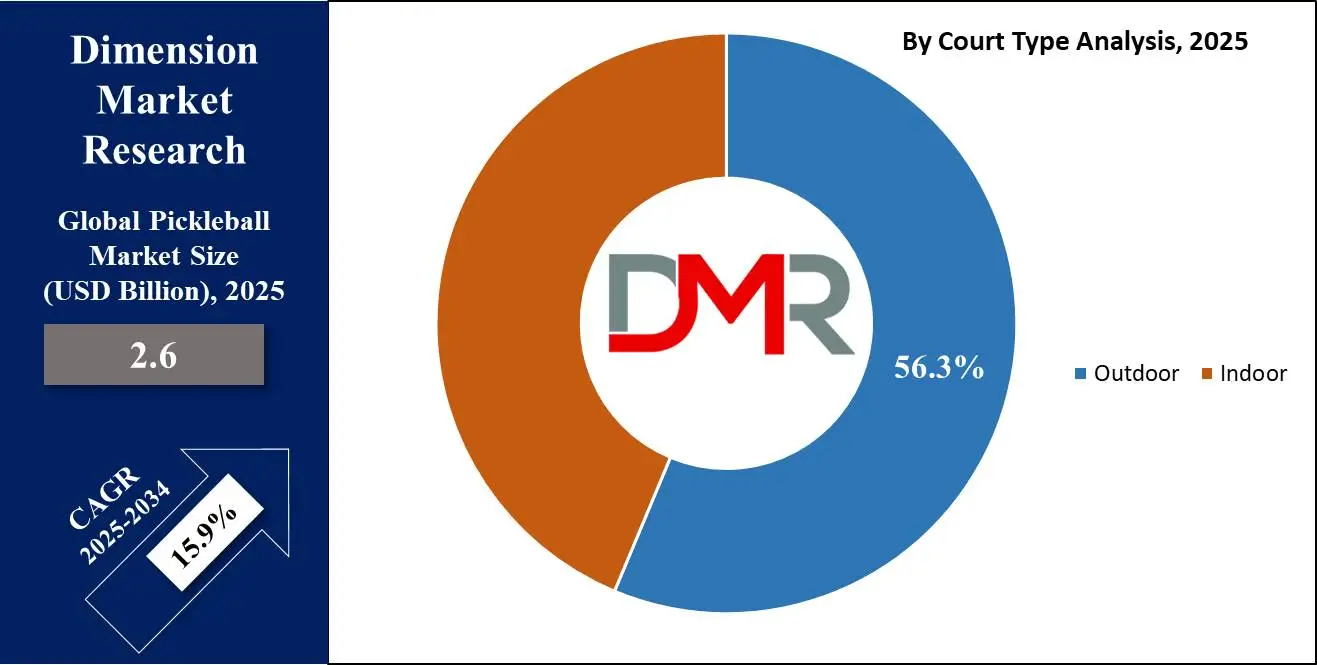
Further, indoor courts are experiencing significant growth over the forecast period, offering year-round play in controlled environments. These facilities attract players who prefer consistent conditions and enhanced amenities. Indoor courts provide shelter from weather extremes, ensuring uninterrupted training and competition. Their growing presence in gyms, sports clubs, and dedicated centers is expanding pickleball’s appeal to a broader audience. Investments in modern lighting, ventilation, and flooring further enhance the indoor experience, making this segment increasingly important for the sport’s overall market development.
By Distribution Channel Analysis
The offline segment is anticipated to lead in 2025 with a 64.6% market share, playing a key role in driving the growth of the pickleball market. Sporting goods stores, mainly shops and large retail chains, provide customers with hands-on experiences, allowing them to test paddles, feel the grip quality, and get expert advice before making a purchase. Many recreational and professional players prefer buying from physical stores to ensure they get the right equipment suited to their playing style.
Offline retailers also build customer trust through personalized service, product demonstrations, and in-store promotions. In addition, partnerships between brands and sports retailers are expanding product availability. With local tournaments and community pickleball programs boosting interest in the sport, offline stores are looking for consistent foot traffic, which remains strong as buyers continue valuing in-person shopping experiences and expert recommendations.
Further, the online segment is having significant growth over the forecast period, driven by convenience, variety, and competitive pricing. E-commerce platforms provide numerous pickleball products, allowing customers to compare brands, read reviews, and find the best deals from anywhere. Online shopping is especially popular among tech-savvy younger players and those in areas with limited access to physical stores.
Major sports brands and marketplaces are expanding their digital presence, offering exclusive discounts and fast delivery options. Social media and influencer marketing are also boosting online sales, as players rely on recommendations from professional athletes and coaches. As more people embrace digital shopping, the online segment continues to reshape the pickleball retail market, making products more accessible to a global audience.
By End User Analysis
The recreational players segment is set to dominate with a 64.6% market share in 2025, playing a major role in the expansion of the pickleball market. The sport's easy learning curve, social appeal, and accessibility have attracted millions of casual players across different age groups. Community centers, parks, and clubs are expanding their pickleball facilities to accommodate the growing demand. Recreational players are driving sales of paddles, balls, nets, and accessories, fueling market growth.
Many beginners start with affordable equipment and later invest in higher-quality gear as they improve. The growth of pickleball leagues, social tournaments, and wellness programs is further boosting participation. With its appeal to families, seniors, and younger players, the recreational segment continues to bring new enthusiasts into the sport, ensuring steady market expansion and long-term growth.
Further, the professional players segment is having significant growth over the forecast period, driven by a rise in tournaments, sponsorships, and media coverage. As competitive pickleball gains recognition, the need for high-performance paddles, apparel, and accessories is expanding. Professional leagues and championship events are attracting skilled athletes, pushing brands to innovate with advanced equipment.
Sponsorship deals and endorsements are helping the market grow, while televised matches and live streaming are making the sport more popular. More players are joining the pro circuit, creating a need for specialized coaching and training facilities. With expanding prize pools and greater audience interest, the professional segment is strengthening the overall pickleball industry.
The Pickleball Market Report is segmented on the basis of the following
By Product Type
- Paddles
- Balls
- Apparel
- Accessories
- Others
By Material
- Composite
- Graphite
- Wood
- Others
By Court Type
By Distribution Channel
By End User
- Recreational Players
- Professional Players
Regional Analysis
Leading Region in the Pickleball Market
North America is expected to dominate the pickleball market in 2025, holding a substantial
48.8% share, valued at approximately
USD 1.2 billion. This growth is fueled by widespread participation across diverse age groups, well-developed community programs, and major investments in dedicated infrastructure. Recreational clubs, local parks, and specialized facilities across the US and Canada have embraced pickleball, making it a popular sport for both leisure and competition. This increased interest has spurred demand for quality equipment, professional coaching, and organized tournaments.
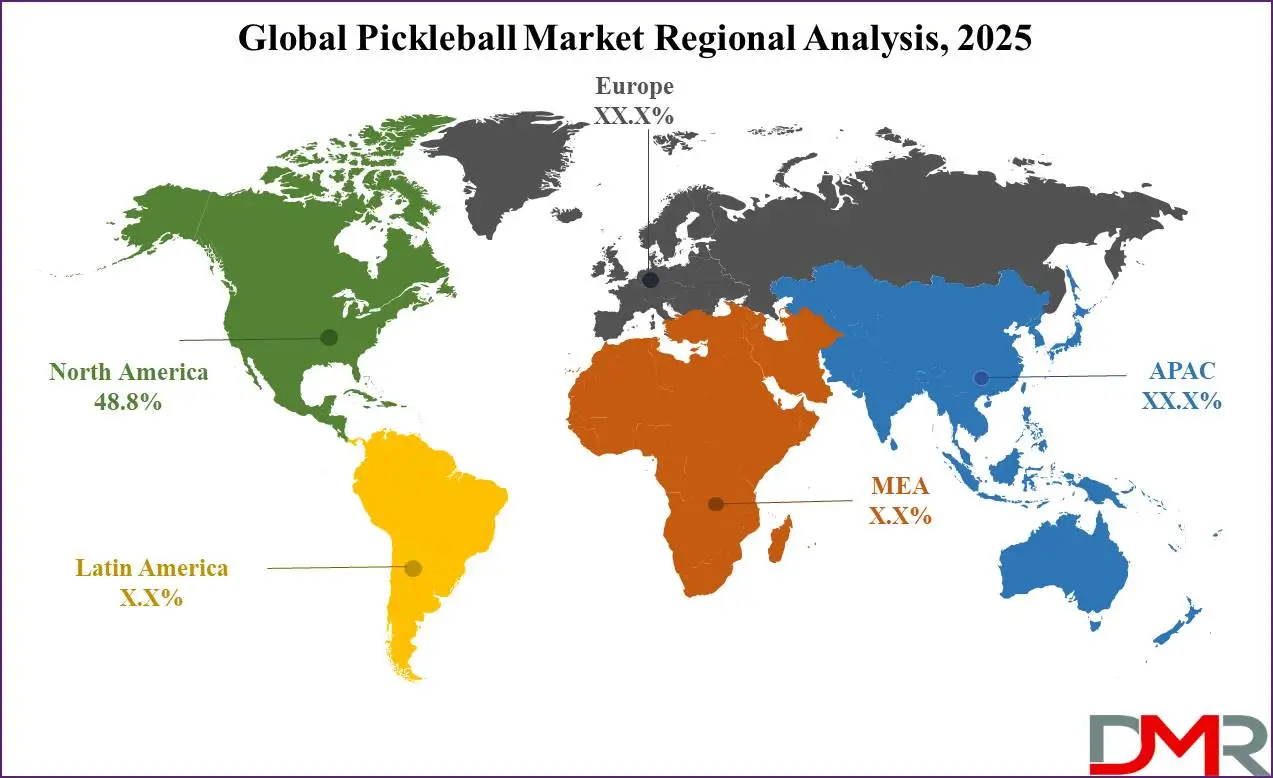
Retailers and online platforms are expanding their product lines, while public and private funding is improving court construction and maintenance. The culture of active lifestyles and wellness in North America further supports the sport’s rapid expansion, creating an environment that continually attracts new players. With strong economic support and a focus on health, the region remains a key driver in advancing the overall growth of the global pickleball market.
Fastest Growing Region in the Pickleball Market
The Asia Pacific region is emerging as a dynamic contributor to the growth of the pickleball market, experiencing significant growth over the forecast period. With a growing interest in health and wellness and an increase in the number of sports facilities adopting new trends, pickleball is rapidly gaining popularity in countries such as China, Japan, and Australia.
Local sports clubs and community centers are introducing pickleball as a fun and accessible sport for all ages, leading to increased participation. Manufacturers are expanding their product lines to cater to the growing demand in these markets. Government initiatives promoting physical activity further bolster the sport’s appeal, making Asia Pacific a fast-growing region for pickleball.
The rapid rise in Pickleball’s popularity is also having a significant impact on the sports equipment industry. In particular, the
U.S. Pickleball Paddle Market has seen remarkable growth. Manufacturers are investing heavily in innovation, producing paddles made with advanced materials like carbon fiber and graphite to meet the needs of both amateur and professional players.
From balls and nets to specialized footwear and high-performance paddles,
Pickleball equipment is becoming a thriving sector within the larger sports equipment market. Retailers and brands focusing on
power sports gear are expanding their offerings to include Pickleball, recognizing the strong consumer demand.
By Region
North America
Europe
- Germany
- The U.K.
- France
- Italy
- Russia
- Spain
- Benelux
- Nordic
- Rest of Europe
Asia-Pacific
- China
- Japan
- South Korea
- India
- ANZ
- ASEAN
- Rest of Asia-Pacific
Latin America
- Brazil
- Mexico
- Argentina
- Colombia
- Rest of Latin America
Middle East & Africa
- Saudi Arabia
- UAE
- South Africa
- Israel
- Egypt
- Rest of MEA
Competitive Landscape
The competitive landscape of the pickleball market is a little consolidated, as larger entities have consolidated their positions through strong distribution networks, extensive marketing strategies, and ongoing innovation in equipment and services. This blend of independent operators and dominant market leaders fosters healthy competition, driving constant improvements in quality and performance. The dynamic environment promotes new entrants while ensuring that established players maintain high standards. As the market evolves, both segments focus on innovation, cost efficiency, and customer satisfaction, ensuring sustained growth and a vibrant competitive atmosphere.
Some of the prominent players in the Global Pickleball are
- Onix Sports
- Franklin Sports
- Selkirk Sport
- Paddle
- CRBN
- Nettie
- Civile
- Pickleball Tutor
- Pickleball Central
- Slinger Bag
- Spinshot Sports
- Lobster Sports
- Nike
- Mizuno
- Prince
- Babolat
- Other Key Players
Recent Developments
- In March 2025, Life Time, North America's largest operator of permanent pickleball courts, announced the Inaugural Agassi Open Play Day, which will feature simultaneous open play across its 785 dedicated courts. Further, the event focuses on uniting players of all levels, with participants having chances to win the new Agassi x JOOLA Pro paddle.
- In April 2024, the United Pickleball Association and Global Sports announced a deal to bring the PPA Tour and Major League Pickleball to the world’s most populous country. It’s the first international deal and major announcement for the United Pickleball Association, which was created after a merger between Major League Pickleball and the Professional Pickleball Association. The PPA Tour and Major League Pickleball retained their distinct brands after the merger. The PPA Tour features an individual bracket-style tour, while MLP is a team-based format.
Report Details
| Report Characteristics |
| Market Size (2025) |
USD 2.6 Bn |
| Forecast Value (2034) |
USD 9.6 Bn |
| CAGR (2025-2034) |
15.9% |
| Historical Data |
2019 – 2024 |
| The US Market Size (2025) |
USD 1.1 Bn |
| Forecast Data |
2025 – 2033 |
| Base Year |
2024 |
| Estimate Year |
2025 |
| Report Coverage |
Market Revenue Estimation, Market Dynamics, Competitive Landscape, Growth Factors and etc. |
| Segments Covered |
By Product Type (Paddles, Balls, Apparel, Accessories, and Others), By Material (Composite, Graphite, Wood, and Others), By Court Type (Outdoor and Indoor), By Distribution Channel (Offline and Online), By End User (Recreational Players and Professional Players) |
| Regional Coverage |
North America – The US and Canada; Europe – Germany, The UK, France, Russia, Spain, Italy, Benelux, Nordic, & Rest of Europe; Asia- Pacific– China, Japan, South Korea, India, ANZ, ASEAN, Rest of APAC; Latin America – Brazil, Mexico, Argentina, Colombia, Rest of Latin America; Middle East & Africa – Saudi Arabia, UAE, South Africa, Turkey, Egypt, Israel, & Rest of MEA
|
| Prominent Players |
Onix Sports, Franklin Sports, Selkirk Sport, Paddle, CRBN, Nettie, Civile, Pickleball Tutor, Pickleball Central, Slinger Bag, Spinshot Sports, Lobster Sports, Nike, Mizuno, Prince, Babolat, and Other Key Players |
| Purchase Options |
We have three licenses to opt for: Single User License (Limited to 1 user), Multi-User License (Up to 5 Users) and Corporate Use License (Unlimited User) along with free report customization equivalent to 0 analyst working days, 3 analysts working days and 5 analysts working days respectively. |